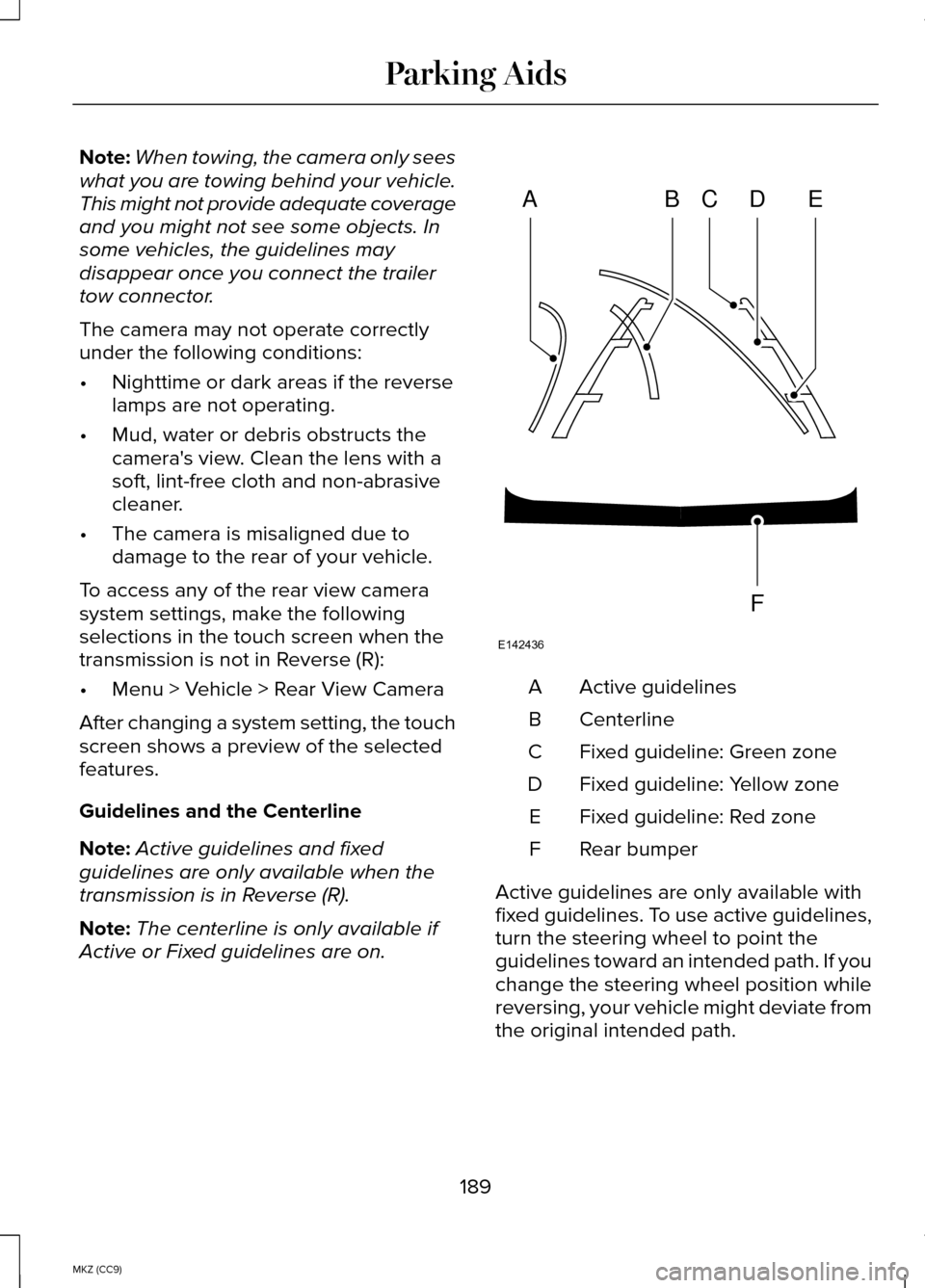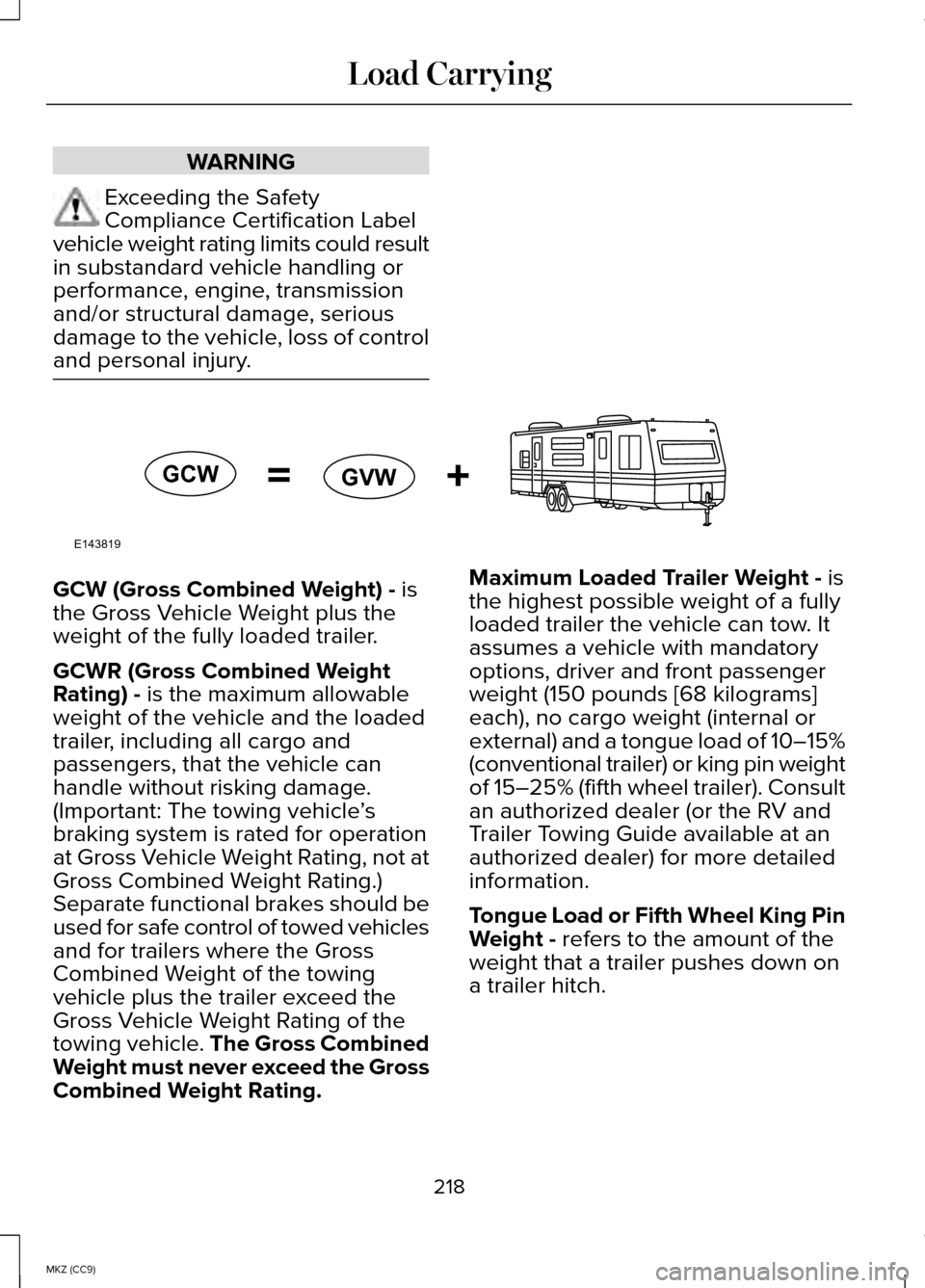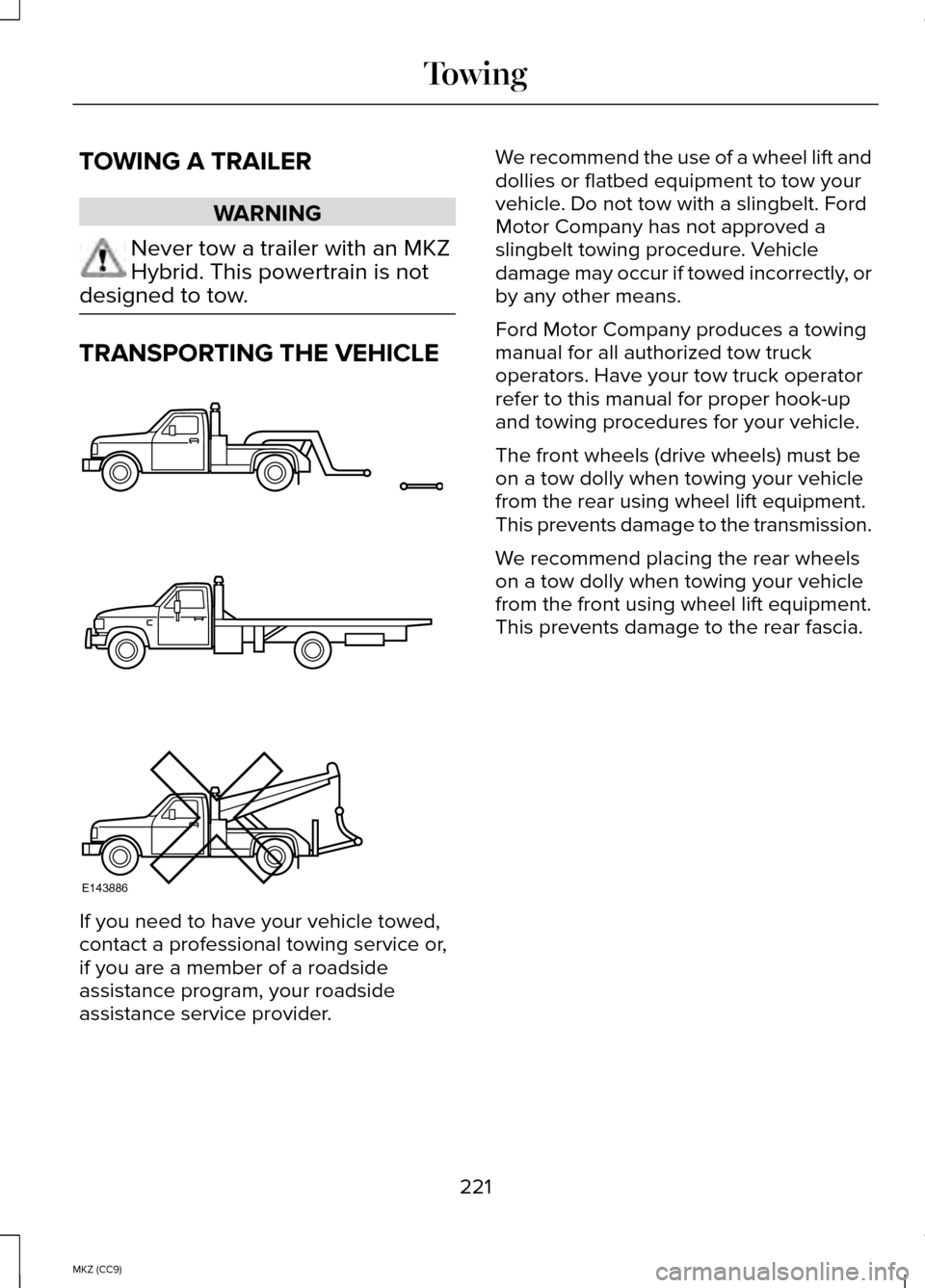2014 LINCOLN MKZ HYBRID transmission
[x] Cancel search: transmissionPage 188 of 445

When you think the vehicle has enough
space in front and behind it, or you hear a
solid tone from the parking aid
(accompanied by a touch screen display
message and a chime), bring the vehicle
to a complete stop.
When automatic steering is finished, the
touch screen displays a message and a
chime sounds, indicating that the active
park assist process is done. The driver is
responsible for checking the parking job
and making any necessary corrections
before putting the transmission in P (Park).
Deactivating the Park Assist Feature
The system can be deactivated manually
by:
•
pressing the active park assist button
• grabbing the steering wheel •
driving above approximately 50 mph
(80 km/h) for 30 seconds during an
active park search
• driving above 6 mph (10 km/h) during
automatic steering
• turning off the traction control system.
Certain vehicle conditions can also
deactivate the system, such as:
• Traction control has activated on a
slippery or loose surface.
• There is an anti-lock brake system
activation or failure.
• Something touches the steering wheel.
If a problem occurs with the system, a
warning message is displayed, followed
by a chime. Occasional system messages
may occur in normal operation. For
recurring or frequent system faults, contact
an authorized dealer to have your vehicle
serviced.
Troubleshooting the System The system does not look for a space
The traction control system may be off
The transmission is in R (Reverse); the vehicle must be moving forward to detect a
parking space
186
MKZ (CC9) Parking AidsE130108
Page 189 of 445

The system does not offer a particular space
Something may be contacting the front bumper or side sensors
There is not enough room on both sides of the vehicle in order to park
There is not enough space for the parking maneuver on the opposite side \
of the parking
space
The vehicle is farther than 6.5 ft (2.0 m) from the parking space
The vehicle is closer than 16 in. (40 cm) from neighboring parked vehicles
The transmission is in R (Reverse); the vehicle must be moving forward to detect a
parking space The system does not position the vehicle where I want in the space
The vehicle is rolling in the opposite direction of the transmission (i\
.e. rolling forward
when R [Reverse] is selected)
An irregular curb along the parking space prevents the system from align\
ing the vehicle
properly
Vehicles or objects bordering the space may not be positioned correctly
The vehicle was pulled too far past the parking space. The system performs best when
you drive the same distance past the parking space
The tires may not be installed or maintained correctly (i.e. not inflated correctly, improper
size, or of different sizes)
A repair or alteration has changed detection capabilities
A parked vehicle has a high attachment (i.e. salt sprayer, snowplow, moving truck bed,
etc.)
The parking space length or position of parked objects changed after your vehicle
passed
The temperature around your vehicle changes quickly (i.e. driving from a heated garage
into the cold, or after leaving a car wash)
187
MKZ (CC9) Parking Aids
Page 190 of 445

REAR VIEW CAMERA (IF EQUIPPED)
WARNINGS
The rear view camera system is a
reverse aid supplement device that
still requires the driver to use it in
conjunction with the interior and exterior
mirrors for maximum coverage. Objects that are close to either
corner of the bumper or under the
bumper, might not be seen on the screen
due to the limited coverage of the camera
system. Back up as slow as possible since
higher speeds might limit your
reaction time to stop the vehicle. Use caution when using the rear
video camera and the trunk is ajar.
If the trunk is ajar, the camera will be out
of position and the video image may be
incorrect. All guidelines (if enabled) have
been removed when the trunk is ajar. Use caution when turning camera
features on or off while in R
(Reverse). Make sure the vehicle is not
moving. The rear view camera system provides a
video image of the area behind your
vehicle. The image will display in either
the rear view mirror or the display in the
center of the instrument panel.
During operation, lines will appear in the
display that represent your vehicle
’s path
and proximity to objects behind your
vehicle. The camera is located on the trunk near
the high-mount brake lamp.
Using the Rear View Camera System
The rear view camera system displays
what is behind your vehicle when you
place the transmission in Reverse (R).
The system uses three types of guides to
help you see what is behind your vehicle:
•
Active guidelines: Show the intended
path of your vehicle when reversing.
• Fixed guidelines: Show the actual path
your vehicle is moving in while
reversing in a straight line. This can be
helpful when backing into a parking
space or aligning your vehicle with
another object behind you.
• Centerline (if applicable): Helps align
the center of your vehicle with an
object (trailer).
Note: If the transmission is in Reverse (R)
and the luggage compartment is ajar, no
rear view camera features will display.
Note: If the image comes on while the
transmission is not in Reverse (R), have
the system inspected by an authorized
dealer.
188
MKZ (CC9) Parking AidsE152548
Page 191 of 445

Note:
When towing, the camera only sees
what you are towing behind your vehicle.
This might not provide adequate coverage
and you might not see some objects. In
some vehicles, the guidelines may
disappear once you connect the trailer
tow connector.
The camera may not operate correctly
under the following conditions:
• Nighttime or dark areas if the reverse
lamps are not operating.
• Mud, water or debris obstructs the
camera's view. Clean the lens with a
soft, lint-free cloth and non-abrasive
cleaner.
• The camera is misaligned due to
damage to the rear of your vehicle.
To access any of the rear view camera
system settings, make the following
selections in the touch screen when the
transmission is not in Reverse (R):
• Menu > Vehicle > Rear View Camera
After changing a system setting, the touch
screen shows a preview of the selected
features.
Guidelines and the Centerline
Note: Active guidelines and fixed
guidelines are only available when the
transmission is in Reverse (R).
Note: The centerline is only available if
Active or Fixed guidelines are on. Active guidelines
A
Centerline
B
Fixed guideline: Green zone
C
Fixed guideline: Yellow zone
D
Fixed guideline: Red zone
E
Rear bumper
F
Active guidelines are only available with
fixed guidelines. To use active guidelines,
turn the steering wheel to point the
guidelines toward an intended path. If you
change the steering wheel position while
reversing, your vehicle might deviate from
the original intended path.
189
MKZ (CC9) Parking AidsABCD
F
E
E142436
Page 192 of 445

The fixed and active guidelines fade in and
out depending on your steering wheel
position. When your steering wheel
position is straight, the active guidelines
are not visible.
Always use caution while reversing.
Objects in the red zone are closest to your
vehicle and objects in the green zone are
farther away. Objects are getting closer to
your vehicle as they move from the green
zone to the yellow or red zones. Use the
side view mirrors and rear view mirror to
get better coverage on both sides and rear
of your vehicle.
Selectable settings for this feature are
ACTIVE + FIXED, FIXED and OFF.
Visual Park Aid Alert
Note:
Visual park alert is only available
when the transmission is in Reverse (R).
Note: The reverse sensing system is not
effective at speeds above 3 mph (5 km/h)
and may not detect certain angular or
moving objects.
The system uses red, yellow and green
highlights that appear on top of the video
image when the reverse sensing system
detects an object. The alert highlights the
closest object detected. You can disable
the reverse sensing alert if you have visual
park aid alert enabled, you will still see the
displayed highlighted areas.
Selectable settings for this feature are ON
and OFF. Manual Zoom WARNING
When manual zoom is on, the full
area behind your vehicle is not
shown. Be aware of your surroundings
when using the manual zoom feature. Note:
Manual zoom is only available when
the transmission is in Reverse (R).
Note: Only the centerline shows when you
enable manual zoom.
This allows you to get a closer view of an
object behind your vehicle. The zoomed
image keeps the bumper in the image to
provide a reference. The zoom is only
active while the transmission is in Reverse
(R). When you shift the transmission out of
Reverse (R), the feature automatically turns
off and you must enable it to use it used
again.
Selectable settings for this feature are ON
and OFF.
Rear Camera Delay
When shifting the transmission out of
Reverse (R) and into any gear other than
Park (P), the camera image remains in the
display until your vehicle speed reaches
5 mph (8 km/h or until you select a radio
button.
Selectable settings for this feature are ON
and OFF. The default setting for the rear
camera delay is OFF.
190
MKZ (CC9) Parking Aids
Page 207 of 445

BLIND SPOT INFORMATION
SYSTEM
Blind Spot Information System
(BLIS®) with Cross Traffic Alert (If
Equipped) WARNING
To help avoid injuries, NEVER use
the BLIS as a replacement for using
the interior and exterior mirrors and
looking over your shoulder before
changing lanes. BLIS is not a replacement
for careful driving and only an assist. BLIS aids you in detecting vehicles that
may have entered the blind spot zone (A).
The detection area is on both sides of the
vehicle, extending rearward from the
exterior mirrors to approximately 10 feet
(3 meters) beyond the bumper. The system
alerts you if certain vehicles enter the blind
spot zone while driving.
Cross traffic alert warns you of vehicles
approaching from the sides when the
transmission is in R (Reverse). Note:
BLIS is not designed to prevent
contact with other vehicles or objects; or
to detect parked vehicles, people, animals
or infrastructure (fences, guardrails, trees,
etc.). It is designed to alert the driver to
vehicles in the blind zones.
Note: When a vehicle passes quickly
through the blind zone, typically fewer
than two seconds, the system does not
trigger.
Using the Systems
BLIS turns on when the vehicle is started
and is driven forward above 5 mph (8
km/h); it remains on while the transmission
is in D (Drive) and N (Neutral). If shifted out
of D (Drive) or N (Neutral), the system
enters cross traffic alert mode. Once
shifted back into D (Drive), BLIS turns back
on when the vehicle is driven above 5 mph
(8 km/h).
Note: BLIS does not function in R (Reverse)
or P (Park) or provide any additional
warning when a turn signal is on.
Note: Cross traffic alert detects
approaching vehicles from up to 45 feet
(14 meters) away though coverage
decreases when the sensors are blocked.
Reversing slowly helps increase the
coverage area and effectiveness. WARNING
To help avoid personal injury, NEVER
use the cross traffic alert system as
a replacement for using the interior and
exterior mirrors and looking over your
shoulder before backing out of a parking
space. Cross traffic alert is not a
replacement for careful driving and only
an assist. 205
MKZ (CC9) Driving AidsA
A
E124788
Page 220 of 445

WARNING
Exceeding the Safety
Compliance Certification Label
vehicle weight rating limits could result
in substandard vehicle handling or
performance, engine, transmission
and/or structural damage, serious
damage to the vehicle, loss of control
and personal injury. GCW (Gross Combined Weight) - is
the Gross Vehicle Weight plus the
weight of the fully loaded trailer.
GCWR (Gross Combined Weight
Rating) -
is the maximum allowable
weight of the vehicle and the loaded
trailer, including all cargo and
passengers, that the vehicle can
handle without risking damage.
(Important: The towing vehicle ’s
braking system is rated for operation
at Gross Vehicle Weight Rating, not at
Gross Combined Weight Rating.)
Separate functional brakes should be
used for safe control of towed vehicles
and for trailers where the Gross
Combined Weight of the towing
vehicle plus the trailer exceed the
Gross Vehicle Weight Rating of the
towing vehicle. The Gross Combined
Weight must never exceed the Gross
Combined Weight Rating. Maximum Loaded Trailer Weight -
is
the highest possible weight of a fully
loaded trailer the vehicle can tow. It
assumes a vehicle with mandatory
options, driver and front passenger
weight (150 pounds [68 kilograms]
each), no cargo weight (internal or
external) and a tongue load of 10–15%
(conventional trailer) or king pin weight
of 15–25% (fifth wheel trailer). Consult
an authorized dealer (or the RV and
Trailer Towing Guide available at an
authorized dealer) for more detailed
information.
Tongue Load or Fifth Wheel King Pin
Weight -
refers to the amount of the
weight that a trailer pushes down on
a trailer hitch.
218
MKZ (CC9) Load CarryingE143819GCW
GVW
Page 223 of 445

TOWING A TRAILER
WARNING
Never tow a trailer with an MKZ
Hybrid. This powertrain is not
designed to tow. TRANSPORTING THE VEHICLE
If you need to have your vehicle towed,
contact a professional towing service or,
if you are a member of a roadside
assistance program, your roadside
assistance service provider. We recommend the use of a wheel lift and
dollies or flatbed equipment to tow your
vehicle. Do not tow with a slingbelt. Ford
Motor Company has not approved a
slingbelt towing procedure. Vehicle
damage may occur if towed incorrectly, or
by any other means.
Ford Motor Company produces a towing
manual for all authorized tow truck
operators. Have your tow truck operator
refer to this manual for proper hook-up
and towing procedures for your vehicle.
The front wheels (drive wheels) must be
on a tow dolly when towing your vehicle
from the rear using wheel lift equipment.
This prevents damage to the transmission.
We recommend placing the rear wheels
on a tow dolly when towing your vehicle
from the front using wheel lift equipment.
This prevents damage to the rear fascia.
221
MKZ (CC9) TowingE143886